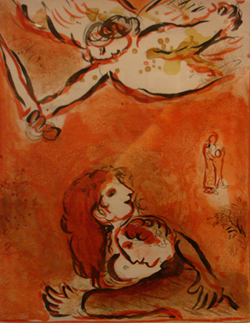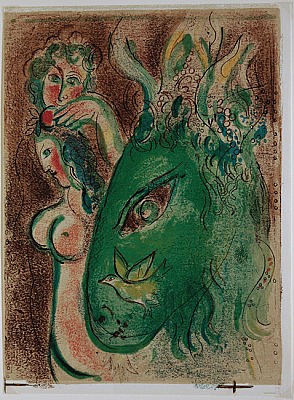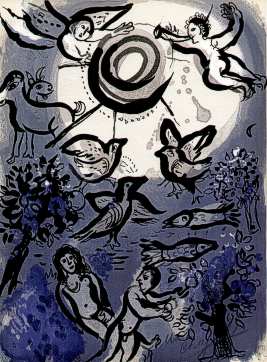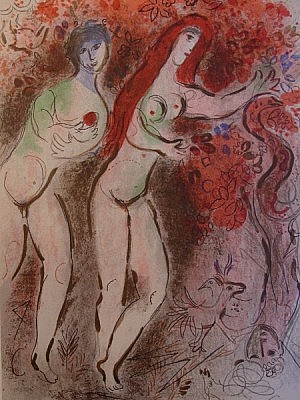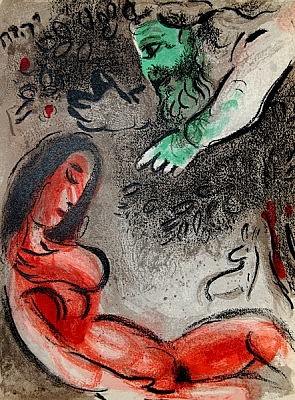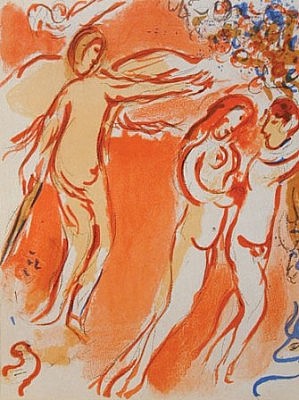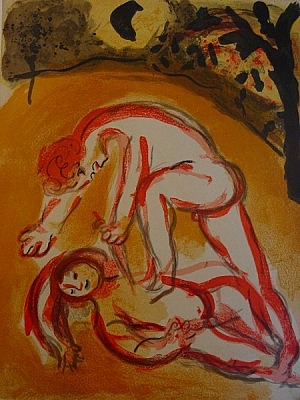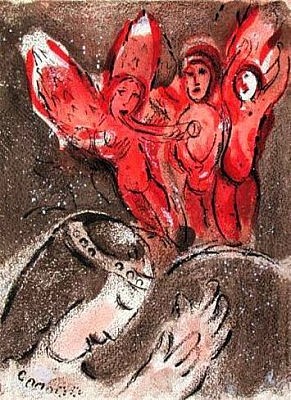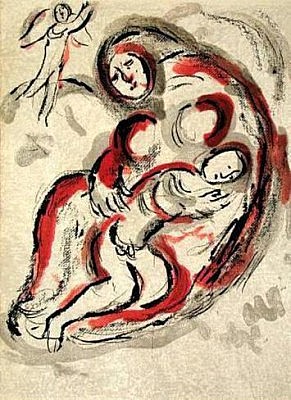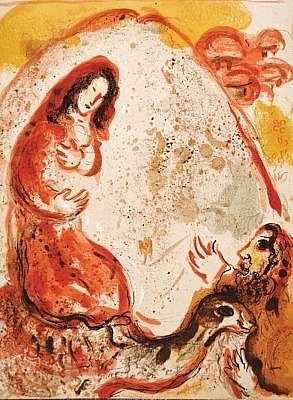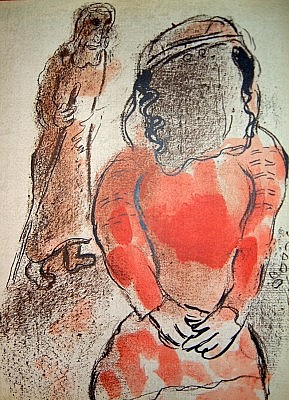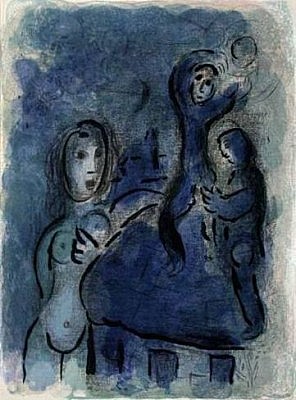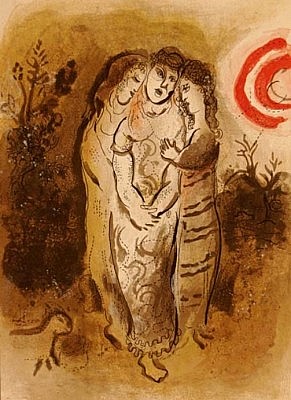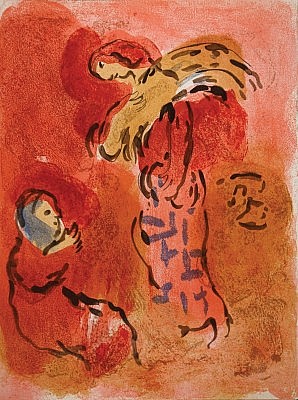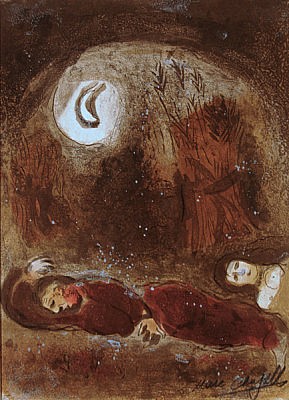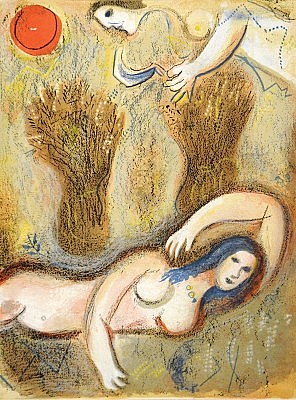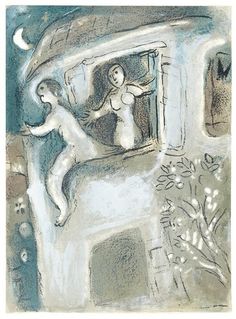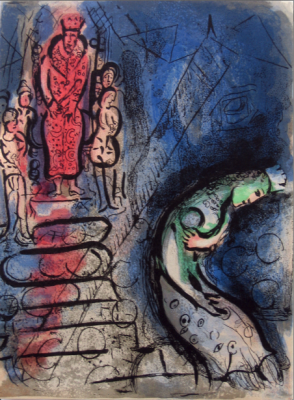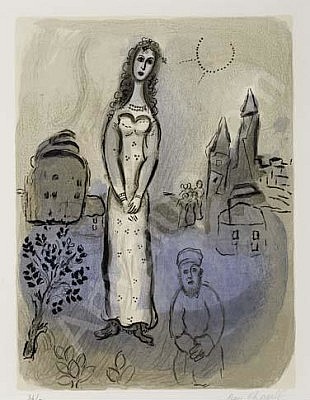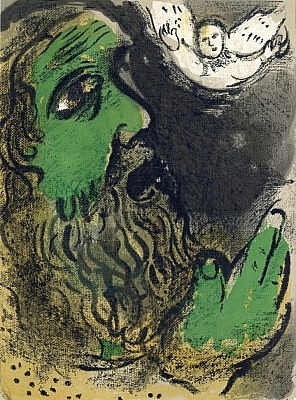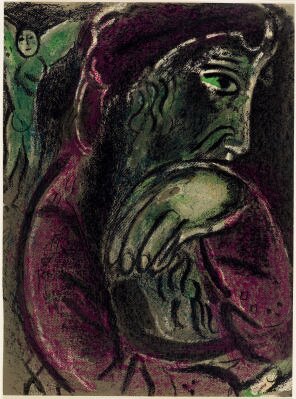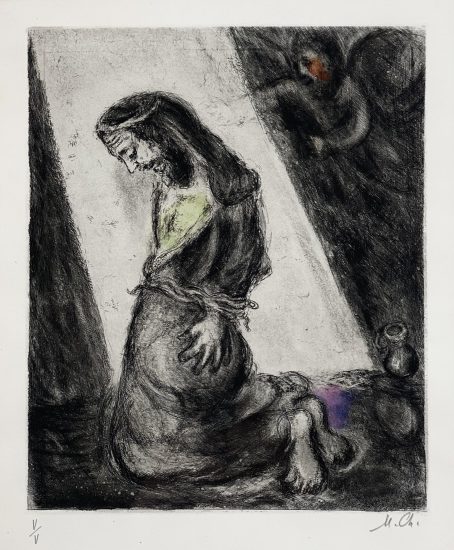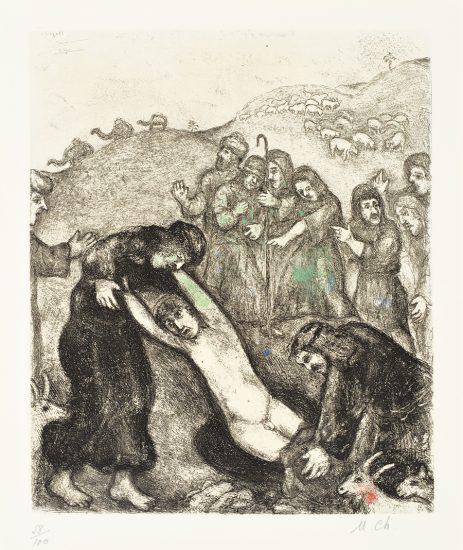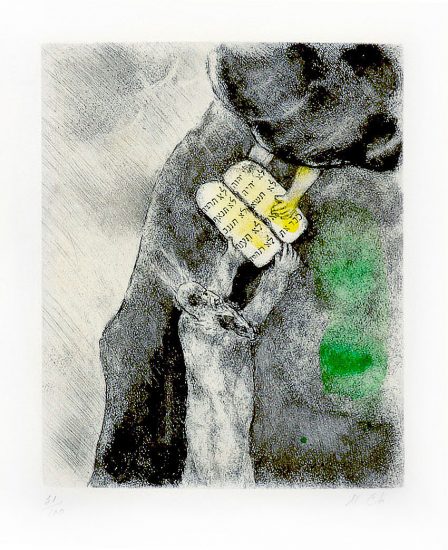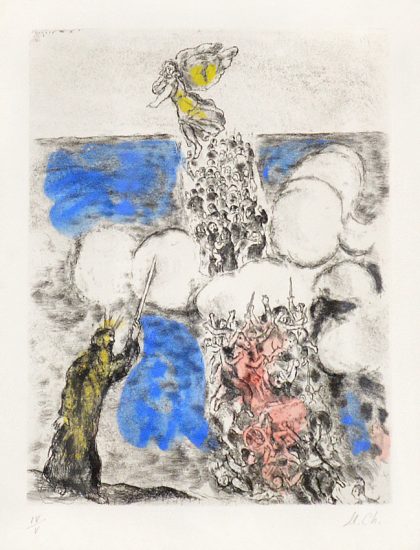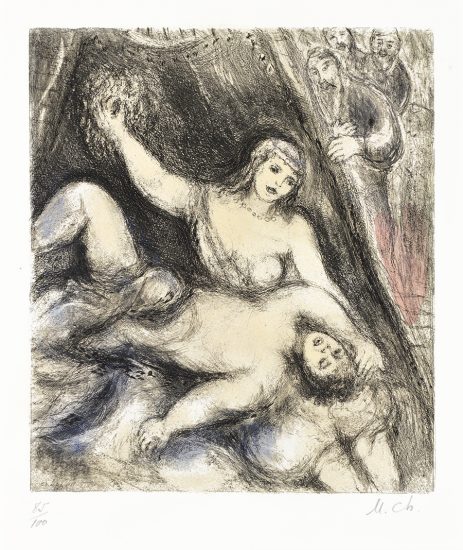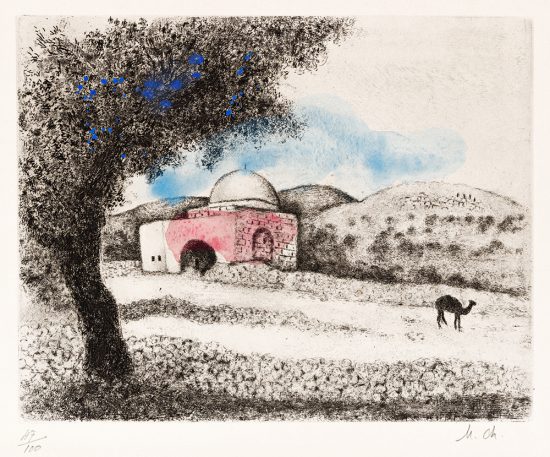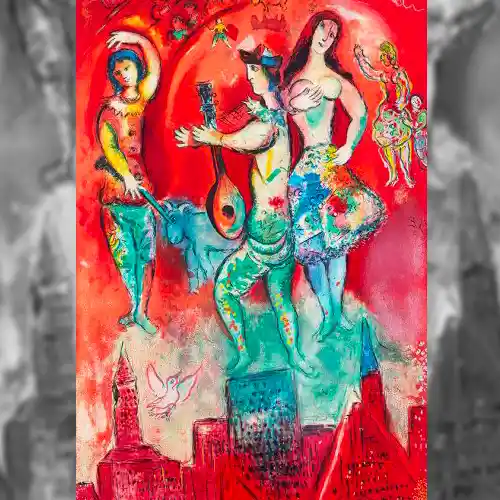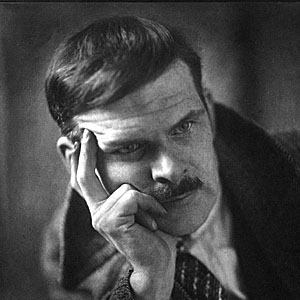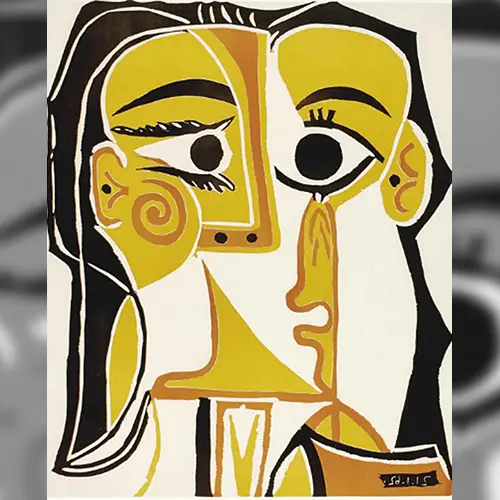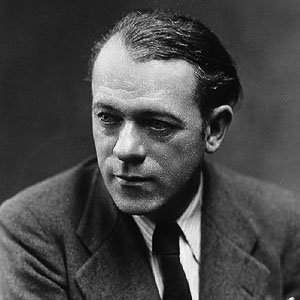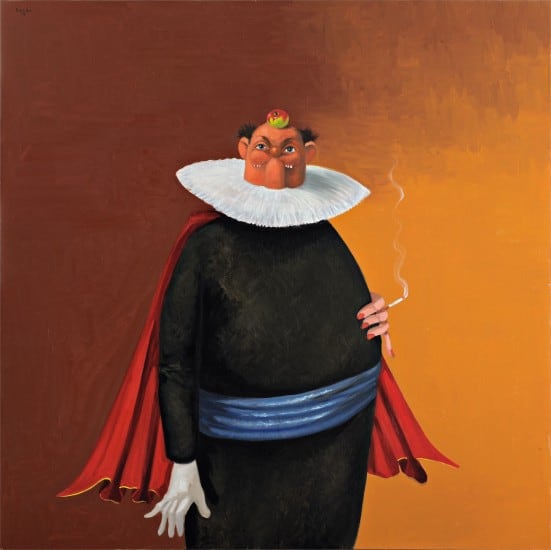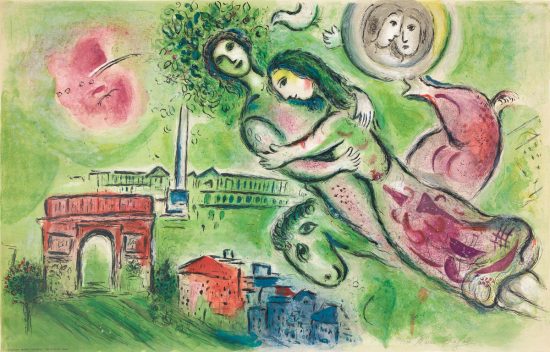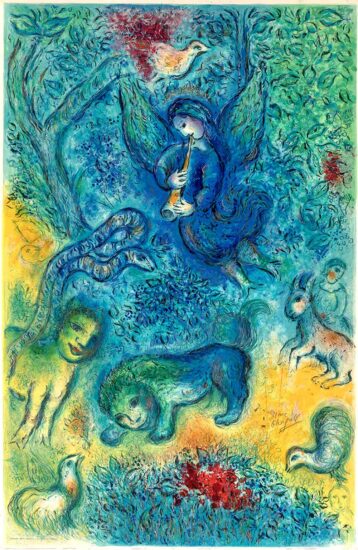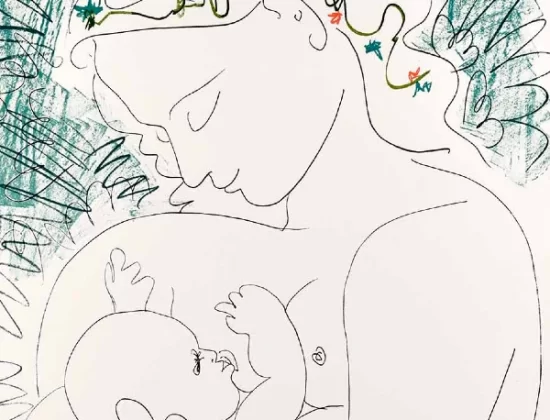Since my early youth, I have been fascinated by the Bible. It has always seemed to me still that it is the greatest source of poetry of all time. Since then I have sought this reflection in life and in art. The Bible is like an echo of nature and this secret I have tried to transmit.
Marc Chagall, on the Bible
Marc Chagall, was a prolific Russian artist whose bright, whimsical, and iconic works catapulted his name into the forefront of the art world. Heralding his Jewish background, Chagall’s compositions would range from references to mid-summer romances along the French Riviera to the Bible.
Long influenced by religion, in the spring of 1931, he traveled to the Holy Land in what became a life-changing experience, both spiritually and creatively. Creating Marc Chagall's The Bible series in 1931-1939 right after his trip and picking it up again twenty five years later in 1952-56, the first series based on his fascination comprised of two volumes and 105 etchings. His second series, which we will be discussing, is the series titled Drawings for the Bible which comprised of 24 color lithographs illustrating tales from the Bible that was published by Verve, Paris and printed by Mourlot, Paris from 1958-1960.
The inspiration for Marc Chagall's Drawings for the Bible was not just from his visit to the Holy Land, but from his own childhood in Russia as well. In Marc Chagall: The Graphic Works, Chagall’s biographer Franz Meyer states, “Chagall’s ties with the Bible are very deep indeed; the forms that people its (the Bible’s) world are a part of his own inner life, part of the living Jewish heritage, and thus are archetypes of a greater, more intensive world.”
In Drawings for the Bible, Chagall conveys the struggles and triumphs of humanity. Drawing from his own sense of spirituality and faith, he carefully selected the scenes that he chose to illustrate. Chagall’s approach to Drawings for the Bible focuses on the intense encounters between God and humanity and reflects his understanding of the Old Testament, highlighting moments of triumph, sorrow, and prophecy. God calls upon his subjects to perform great acts, yet his subjects are still human, capable of weakness, doubt, treachery, and lust. Utilizing a vibrant color palette, dramatic shading, and fanciful imagery, these powerful themes and emotions are captured in Chagall's 24 stunning lithographic prints from Drawings for the Bible.
Le Visage d'Israël (The Face of Israel): Refers to Hosea 7:10: “Though the pride of Israel testifies against him,Yet they have not returned to the LORD their God, Nor have they sought Him, for all this.” From the Book of Hosea, this expresses the fact that the people were so sure of their standing with God that they did nothing to assure its continuance. They thought of themselves as God's chosen people, and they felt they were beyond being judged of God. Pride, of this kind, comes just before a fall, but as the rest of Hosea shows, God will always bring them back to the light.
Paradis (Paradise): Refers to Genesis 1:30: “and to every beast of the earth and to every bird of the sky and to every thing that moves on the earth which has life, I have given every green plant for food"; and it was so.” From the Book of Genesis, in which God creates the world.
Paradis (Paradise): Refers to Genesis 2:8: “The LORD God planted a garden toward the east, in Eden; and there He placed the man whom He had formed.” From the Book of Genesis, in which God creates the world.
*Note: the above two works, Marc Chagall named the same.
Création (Creation): Refers to Genesis 1:1: “In the beginning God created the heaven and the earth.” From the Book of Genesis, in which God creates everything.
Adam et Ève et le Fruit défendu (Adam and Eve and the Forbidden Fruit): Refers to Genesis 2:16–17: “And the LORD God commanded the man, saying: 'Of every tree of the garden thou mayest freely eat; but of the tree of the knowledge of good and evil, thou shalt not eat of it; for in the day that thou eatest thereof thou shalt surely die.' From the Book of Genesis, in which after creating the world God creates man, Adam, and appoints him as his regent, with a desire for him not eat the forbidden fruit.
Ève maudite par Dieu (Eve Incurs God’s Displeasure): Refers to Genesis 3:12: “Then the LORD God said to the woman, "What is this you have done?" And the woman said, "The serpent deceived me, and I ate." From the Book of Genesis, in which after creating Adam, God crates Eve from his rib, and God set’s his wrath upon Eve at having been deceived by the snake and eating the forbidden fruit.
Adam et Ève chassés du Paradis terrestre (Adam and Eve are banished from Paradise): Refers to Genesis 3:23: “So He drove the man out; and at the east of the garden of Eden He stationed the cherubim and the flaming sword which turned every direction to guard the way to the tree of life.” From the Book of Genesis in which God exiles Adam and Eve from the Garden of Eden due to their sin of eating the forbidden fruit.
Caïn et Abel (Cain and Abel): Refers to Genesis 4:8: “Cain told Abel his brother. And it came about when they were in the field, that Cain rose up against Abel his brother and killed him.” From the Book of Genesis, this part tells the story of Adam and Eve’s sons Abel and Cain. Abel kills Cain due to jealousy and anger.
Sara et Abimelech (Sarah and Abimelech): Refers to Genesis 20:2: “Abraham said of Sarah his wife, "She is my sister." So Abimelech king of Gerar sent and took Sarah.” From the Book of Genesis, in which this part tells the story of King Abimelech who takes Sarah from Abraham and upon God’s urging gives Abraham her back, as well as land, sheep and servants to erase the curse upon him that God gave him for the sin.
Sara et les Anges (Sarah and the Angels): Genesis 21:1 “Then the LORD took note of Sarah as He had said, and the LORD did for Sarah as He had promised.” From the Book of Genesis, in which this part tells the story of how three angels visit the prophet Abraham and his wife Sarah to announce that God will give them an incredible blessing, a child, despite the fact that both are elderly.
Agar dans le Désert (Hagar in the Desert): Refers to Genesis 21:15- 16 “When the water in the skin was used up, she left the boy under one of the bushes; Then she went and sat down opposite him, about a bowshot away, for she said, "Do not let me see the boy die." And she sat opposite him, and lifted up her voice and wept.” From the Book of Genesis, in which this part tells the story of how Sarah became jealous of Hagar’s son with Abraham and so Abraham sent her with the boy into the desert where God hears their plight and gifts the son a nation of his own.
Rachel dérobe les Idoles de son Père (Rachel hides her Father’s Household Gods): Refers to Genesis 31:34: “Now Rachel had taken the household idols and put them in the camel's saddle, and she sat on them. And Laban felt through all the tent but did not find them.” From the Book of Genesis, in which this part tells of how Rachel, daughter of Laban, was one of the two wives of her cousin Jacob and how in the midst of leaving her father, she took his idols with her which angered him.
Tamar Belle-Fille de Juda (Tamar Daughter-in-Law of Judah): Refers to Genesis 38:1: “Judah then said to his daughter-in-law Tamar, “Live as a widow in your father’s household until my son Shelah grows up.” For he thought, “He may die too, just like his brothers.” So Tamar went to live in her father’s household.” From the Book of Genesis, in which Tamar first married Judah's eldest son, Er but because of his wickedness, Er was killed by God. After his death Judah asked his second son, Onan, to provide offspring for Tamar so that the family line might continue, but Onan refused and died prematurely. Judah then viewed Tamar to be cursed and refused to give her anymore sons.
Rahab et les Espions de Jéricho (Rehab and the Spies of Jericho): Refers to Joshua 6:23: “And the young men that were spies went in, and brought out Rahab, and her father, and her mother, and her brethren, and all that she had; and they brought out all her kindred, and left them without the camp of Israel.” From the Book of Joshua, this part tells the story of Rahab who ran an inn built on the Jericho city wall where she hid the spies of Joshua on her rooftop. Misleading the King, Rahab pleaded for her life and for the lives of her family members through the spies. Once Jericho fell, Joshua gave orders to rescue Rahab and all in her house and they were adopted by the Jews and stayed with them.
Noémie et ses Belles-Filles (Naomi and her Daughters-in-Law): Refers to Ruth 1:8: “And Naomi said to her two daughters-in-law, "Go, return each of you to her mother's house. May the LORD deal kindly with you as you have dealt with the dead and with me.” From the Book of Ruth, this part tells the story of Naomi who had two daughter-in-laws Ruth and Orpah.
Ruth glaneuse (Ruth Gleaning): Refers to Ruth 2:3: “So she stayed close by the maids of Boaz in order to glean until the end of the barley harvest and the wheat harvest. And she lived with her mother-in-law.” From the Book of Ruth, in which Ruth refused to leave her mother-in-law Naomi and returned with her to Bethlehem. In order to take care of her, Ruth went to work in the fields and impressed Boaz, one of the owners of fields, that he encouraged her to work for him and they later were married.
Recontre de Ruth et de Booz (Meeting of Ruth and Boaz): Refers to Ruth 2:5-6: “Then Boaz said to his servant who was in charge of the reapers, "Whose young woman is this?" ; The servant in charge of the reapers replied, "She is the young Moabite woman who returned with Naomi from the land of Moab.” From the Book of Ruth, in which Ruth refused to leave her mother-in-law Naomi and returned with her to Bethlehem. In order to take care of her, Ruth went to work in the fields and impressed Boaz, one of the owners of fields, that he encouraged her to work for him and they later were married.
Ruth aux Pieds de Booz (Ruth at the Feet of Boaz): Refers to Ruth 3:7: “When Boaz had eaten and drunk and his heart was merry, he went to lie down at the end of the heap of grain; and she came secretly, and uncovered his feet and lay down.” From the Book of Ruth, in which Ruth refused to leave her mother-in-law Naomi and returned with her to Bethlehem. In order to take care of her, Ruth went to work in the fields and impressed Boaz, one of the owners of fields, that he encouraged her to work for him and they later were married.
Booz se réveille et voit Ruth à ses Pieds (Boaz Wakes Up and Sees Ruth at his Feet): Refers to Ruth 3:8-9: “It happened in the middle of the night that the man was startled and bent forward; and behold, a woman was lying at his feet. 9He said, "Who are you?" And she answered, "I am Ruth your maid. So spread your covering over your maid, for you are a close relative.” From the Book of Ruth, in which Ruth refused to leave her mother-in-law Naomi and returned with her to Bethlehem. In order to take care of her, Ruth went to work in the fields and impressed Boaz, one of the owners of fields, that he encouraged her to work for him and they later were married.
David sauvé par Michal (David Saved by Michal): Refers to 1 Samuel 19:11-12: “Then Saul sent messengers to David's house to watch him, in order to put him to death in the morning. But Michal, David's wife, told him, saying, "If you do not save your life tonight, tomorrow you will be put to death; So Michal let David down through a window, and he went out and fled and escaped.” From the Book of Samuel, this part describes David's first marriage to Michal, the younger daughter of his rival, King Saul, which was a political alliance that through her help allowed him to become King.
Assuérus chasse Vasthi (Ahasuerus send Vasthi Away): Refers to Esther 1:10-12: “On the seventh day, when the heart of the king was merry with wine, he commanded Mehuman, Biztha, Harbona, Bigtha, Abagtha, Zethar and Carkas, the seven eunuchs who served in the presence of King Ahasuerus,; to bring Queen Vashti before the king with her royal crown in order to display her beauty to the people and the princes, for she was beautiful.; But Queen Vashti refused to come at the king's command delivered by the eunuchs. Then the king became very angry and his wrath burned within him.” From the Book of Esther, this part tells the story of Vasthi, the wife of King Ahasuerus who was put away for refusing to exhibit herself at a royal banquet.
Esther (Esther): Refers to Esther 2:7: "And he brought up Hadassah, that is, Esther, his uncle's daughter: for she had neither father nor mother, and the maid was fair and beautiful; whom Mordecai, when her father and mother were dead, took for his own daughter." Esther was the daughter of a Benjamite, Abihail. When Cyrus gave permission for the exiles to return unto Jerusalem she stayed with Mordecai.” From the Book of Esther, in which Esther replaces the disposed Queen Vashti and marries King Ahasuerus.
Job en Prierè (Job Praying): Refers to Job 1:20: “Then Job arose and tore his robe and shaved his head, and he fell to the ground and worshiped.” From the Book of Job, in which Job, a family man who lives a good and prosperous life, is eventually beset with horrendous disasters that take away all he has, including his family, his health, and his property. Job struggles to understand his situation and begins a long search for the right path that will get him out of his extremely difficult situation. Against all odds, and with God's help, Job is restored to a semblance of his earlier existence.
Job désespéré (Job in Despair): Refers to Job 3:11: “"Why did I not die at birth, Come forth from the womb and expire?” From the Book of Job, in which Job, a family man who lives a good and prosperous life, is eventually beset with horrendous disasters that take away all he has, including his family, his health, and his property. Job struggles to understand his situation and begins a long search for the right path that will get him out of his extremely difficult situation. Against all odds, and with God's help, Job is restored to a semblance of his earlier existence.
MORE MARC CHAGALL SERIES:
- Marc Chagall, Bible Series, 1958
- Marc Chagall, Nice and the Côt’d Azur Lithograph Series
- Marc Chagall, Daphnis and Chloe Lithograph Series
EXHIBITIONS:
- 2012 exhibition of Marc Chagall's Drawings from the Bible series, The Sherwin Miller Museum of Jewish Art
- Marc Chagall Satellite exhibit, Marc Chagall Drawing's from the Bible series, Museum of Ancient and Modern Art
BOOKS:
- Patrick Cramer. Marc Chagall, The Illustratred Books
- Distributed Art Publishers, Marc Chagall The Lithographs, La Collection Sorlier

